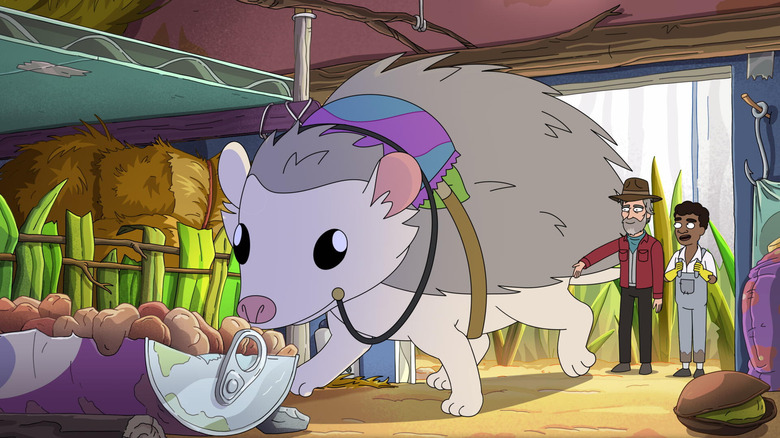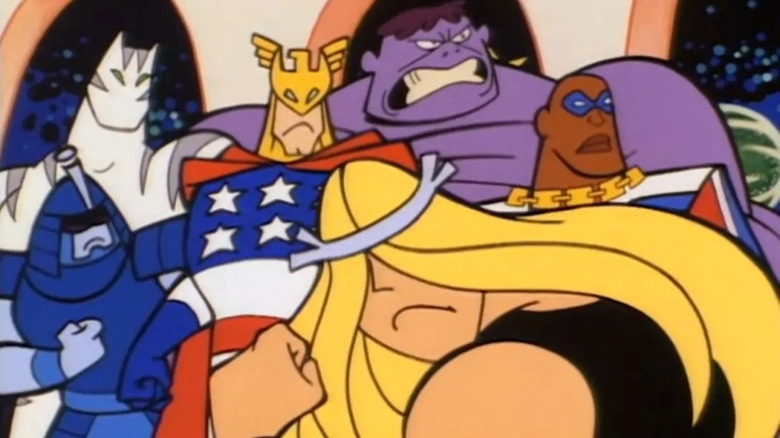Solar Opposites Keeps A Long-Standing Tradition Of Classic Cartoons Alive And Well
"Solar Opposites" is back for season 5, and the show is as funny as ever. The adult animated sitcom created by Mike McMahan and disgraced animator Justin Roiland continues to blend the sci-fi lunacy of "Rick and Morty" with classic family sitcom tropes without veering too much into a single territory, keeping audiences on their toes as they watch. The stories about this alien family reluctantly coming to love planet Earth despite how much they complain about it, choosing time and time again to stay here when it's a detriment to their mission, are funny. Still, it's in the B-plots where the show truly shines.
The first of these B-plots is The Wall, a recurring segment taking place in a terrarium of one of the alien kids, who continuously shrinks random people against their will when he feels they wrong him, and puts them in the terrarium. After a while, The Wall became a full society, and its segments have crossed over into several genres, parodying "The Handmaid's Tale," a David Fincher-style detective mystery thriller, and now a spaghetti western.
But that's not the only recurring segment on "Solar Opposites," because in recent years, the show has also added the SilverCops, a subplot about a neighbor of the Solar Opposites who is shot up to space and is recruited by space cops. He has gone through several trials and tribulations, uncovering conspiracies and oppression in a parody of the 1986 Rankin-Bass animated series "SilverHawks."
As great as the two segments are on their own, they make "Solar Opposites" better as a whole. A show so ingrained in pop culture and the history of TV as this one having two distinct segments also echoes a long tradition in American animation: Having standalone segments ready to be spun off into their own shows.
Solar Opposites is part of a long animated tradition
The segments in "Solar Opposites" work not only because of how funny they are, but because they are clearly part of the same story, yet they work as little spin-offs. Having the aliens and their replicas have a story about opening an exclusive school to feel like elitists, only for the show to cut away to their former neighbor at a police academy in space feels random, funny, and is part of a long tradition.
Back in the day, it was more common for live-action shows to get animated spin-offs, but also for animated shows to have segments as try-outs for potential spin-offs. It was particularly easy to do in the age of 24-minute cartoons made up of two 12-minute segments, as you can simply have a main title show followed by a secondary segment. Legendary studio Hanna-Barbera did this all the time, with cartoons like "The Huckleberry Hound Show" also including a "Pixie and Dixie and Mr. Jinks" segment as well as a "Yogi Bear" segment that eventually became its own separate cartoon.
In the '90s, "Animaniacs" was comprised of several segments following different characters that had nothing to do with one another, like "Pinky and the Brain," which eventually also became its own show. This tradition was followed by the first Cartoon Cartoons, with "Dexter's Laboratory" having the "Dial M for Monkey" and "Justice Friends" segments that delivered compelling and entertaining stories separate from those of Dexter and his sister.
While "Rick and Morty" was a shock to the system of American adult animated shows, "Solar Opposites" is a celebration of the history of TV — both live-action and animation — and to see it continue to embrace the history of these cartoon segments remains a total joy.

